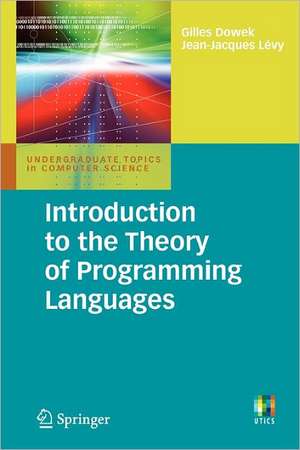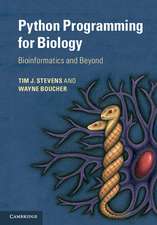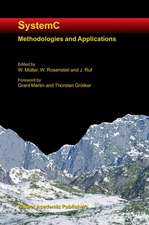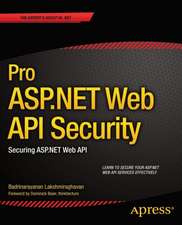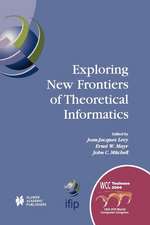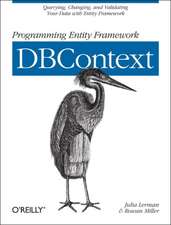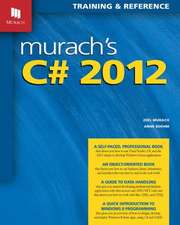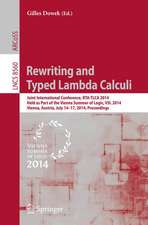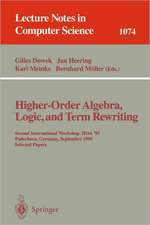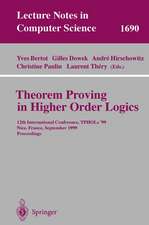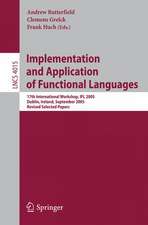Introduction to the Theory of Programming Languages: Undergraduate Topics in Computer Science
Autor Gilles Dowek, Jean-Jacques Lévyen Limba Engleză Paperback – 15 dec 2010
Din seria Undergraduate Topics in Computer Science
- 20%
 Preț: 304.13 lei
Preț: 304.13 lei - 20%
 Preț: 233.75 lei
Preț: 233.75 lei - 20%
 Preț: 350.89 lei
Preț: 350.89 lei - 20%
 Preț: 306.58 lei
Preț: 306.58 lei - 20%
 Preț: 187.22 lei
Preț: 187.22 lei - 20%
 Preț: 272.43 lei
Preț: 272.43 lei - 20%
 Preț: 280.93 lei
Preț: 280.93 lei - 20%
 Preț: 245.43 lei
Preț: 245.43 lei - 20%
 Preț: 305.61 lei
Preț: 305.61 lei - 20%
 Preț: 258.79 lei
Preț: 258.79 lei - 20%
 Preț: 376.76 lei
Preț: 376.76 lei - 20%
 Preț: 246.39 lei
Preț: 246.39 lei - 20%
 Preț: 336.99 lei
Preț: 336.99 lei - 20%
 Preț: 341.22 lei
Preț: 341.22 lei - 20%
 Preț: 192.73 lei
Preț: 192.73 lei - 20%
 Preț: 306.72 lei
Preț: 306.72 lei - 20%
 Preț: 384.11 lei
Preț: 384.11 lei - 20%
 Preț: 316.07 lei
Preț: 316.07 lei - 20%
 Preț: 374.37 lei
Preț: 374.37 lei - 20%
 Preț: 225.03 lei
Preț: 225.03 lei - 20%
 Preț: 226.65 lei
Preț: 226.65 lei - 20%
 Preț: 375.54 lei
Preț: 375.54 lei - 20%
 Preț: 395.05 lei
Preț: 395.05 lei - 20%
 Preț: 307.17 lei
Preț: 307.17 lei - 20%
 Preț: 254.37 lei
Preț: 254.37 lei -
 Preț: 334.89 lei
Preț: 334.89 lei - 20%
 Preț: 227.16 lei
Preț: 227.16 lei - 20%
 Preț: 304.37 lei
Preț: 304.37 lei - 20%
 Preț: 316.24 lei
Preț: 316.24 lei - 20%
 Preț: 287.03 lei
Preț: 287.03 lei - 20%
 Preț: 342.46 lei
Preț: 342.46 lei - 20%
 Preț: 276.82 lei
Preț: 276.82 lei - 20%
 Preț: 237.35 lei
Preț: 237.35 lei - 20%
 Preț: 374.20 lei
Preț: 374.20 lei - 20%
 Preț: 304.44 lei
Preț: 304.44 lei - 20%
 Preț: 297.28 lei
Preț: 297.28 lei - 20%
 Preț: 579.37 lei
Preț: 579.37 lei - 20%
 Preț: 298.18 lei
Preț: 298.18 lei - 20%
 Preț: 243.35 lei
Preț: 243.35 lei - 20%
 Preț: 302.80 lei
Preț: 302.80 lei - 20%
 Preț: 297.66 lei
Preț: 297.66 lei - 20%
 Preț: 300.89 lei
Preț: 300.89 lei - 20%
 Preț: 191.36 lei
Preț: 191.36 lei - 20%
 Preț: 278.11 lei
Preț: 278.11 lei - 20%
 Preț: 304.21 lei
Preț: 304.21 lei - 20%
 Preț: 389.96 lei
Preț: 389.96 lei
Preț: 233.33 lei
Preț vechi: 291.66 lei
-20% Nou
Puncte Express: 350
Preț estimativ în valută:
44.65€ • 47.74$ • 37.23£
44.65€ • 47.74$ • 37.23£
Carte tipărită la comandă
Livrare economică 17 aprilie-01 mai
Preluare comenzi: 021 569.72.76
Specificații
ISBN-13: 9780857290755
ISBN-10: 0857290754
Pagini: 96
Ilustrații: XII, 96 p.
Dimensiuni: 155 x 235 x 6 mm
Greutate: 0.16 kg
Ediția:2011
Editura: SPRINGER LONDON
Colecția Springer
Seria Undergraduate Topics in Computer Science
Locul publicării:London, United Kingdom
ISBN-10: 0857290754
Pagini: 96
Ilustrații: XII, 96 p.
Dimensiuni: 155 x 235 x 6 mm
Greutate: 0.16 kg
Ediția:2011
Editura: SPRINGER LONDON
Colecția Springer
Seria Undergraduate Topics in Computer Science
Locul publicării:London, United Kingdom
Public țintă
GraduateCuprins
1. Terms and Relations.- 2. The Language PCF.- 3. From Evaluation to Interpretation.- 4. Compilation.- 5. PCF with Types.- 6. Type Inference.- 7. References and Assignment.- 8. Records and Objects.- 9. Epilogue.- 10. Index.- 11. Bibliography.
Recenzii
From the reviews:
“The book is divided into eight chapters and an epilogue. … Faculty teaching an undergraduate programming languages course may find this book to be a useful reference. Summing Up: Recommended. Upper-division undergraduates through professionals/practitioners.” (J. Beidler, Choice, Vol. 48 (10), June, 2011)
“It is a short book--of about 100 pages--consisting of eight chapters and an epilogue. The book focuses on the formal description of programming language semantics and compilation using denotational semantics, small-step operational semantics (reduction semantics), and big-step operational semantics (natural semantics). … The book provides a good description of programming language concepts and motivates the necessary theory well. … The book is suitable for both professionals and graduate- and advanced undergraduate-level classes.” (Michael Oudshoorn, ACM Computing Reviews, November, 2011)
“The book is divided into eight chapters and an epilogue. … Faculty teaching an undergraduate programming languages course may find this book to be a useful reference. Summing Up: Recommended. Upper-division undergraduates through professionals/practitioners.” (J. Beidler, Choice, Vol. 48 (10), June, 2011)
“It is a short book--of about 100 pages--consisting of eight chapters and an epilogue. The book focuses on the formal description of programming language semantics and compilation using denotational semantics, small-step operational semantics (reduction semantics), and big-step operational semantics (natural semantics). … The book provides a good description of programming language concepts and motivates the necessary theory well. … The book is suitable for both professionals and graduate- and advanced undergraduate-level classes.” (Michael Oudshoorn, ACM Computing Reviews, November, 2011)
Notă biografică
Gilles Dowek is a Professor at École Polytechnique. He is also a Researcher at the Laboratoire d'Informatique de l'École Polytechnique and the Institut National de Recherche en Informatique et en Automatique (INRIA). His research concerns the formalization of mathematics and the mechanization of reasoning. His main contribution is a reformulation of the axiomatic method which provides a central role to the notion of computation. Jean-Jacques Lévy is a senior scientist at the Institut National de Recherche en Informatique et en Automatique and a Professor at École Polytechnique. He has successively worked on operational and denotational semantics of programming languages, on reduction strategies in lambda-calculus and in rewrite systems, on the computer aided design of circuits and on the semantics of concurrency with applications to distribution and mobility.
Textul de pe ultima copertă
The design and implementation of programming languages, from Fortran and Cobol to Caml and Java, has been one of the key developments in the management of ever more complex computerized systems. Introduction to the Theory of Programming Languages gives the reader the means to discover the tools to think, design, and implement these languages.It proposes a unified vision of the different formalisms that permit definition of a programming language: small steps operational semantics, big steps operational semantics, and denotational semantics, emphasising that all seek to define a relation between three objects: a program, an input value, and an output value. These formalisms are illustrated by presenting the semantics of some typical features of programming languages: functions, recursivity, assignments, records, objects, ... showing that the study of programming languages does not consist of studying languages one after another, but is organized around the features that arepresent in these various languages. The study of these features leads to the development of evaluators, interpreters and compilers, and also type inference algorithms, for small languages.
Caracteristici
Introduction to the Theory of Programming Languages gives the reader the means to discover the tools to think, design, and implement programming languages Proposes a unified vision of the different formalisms that permit definition of a programming language Presents in a synthetic way what all computer scientists, whatever their speciality is, should know Includes supplementary material: sn.pub/extras
